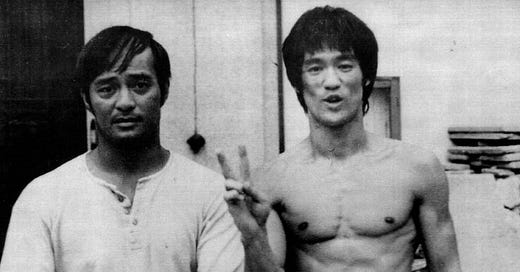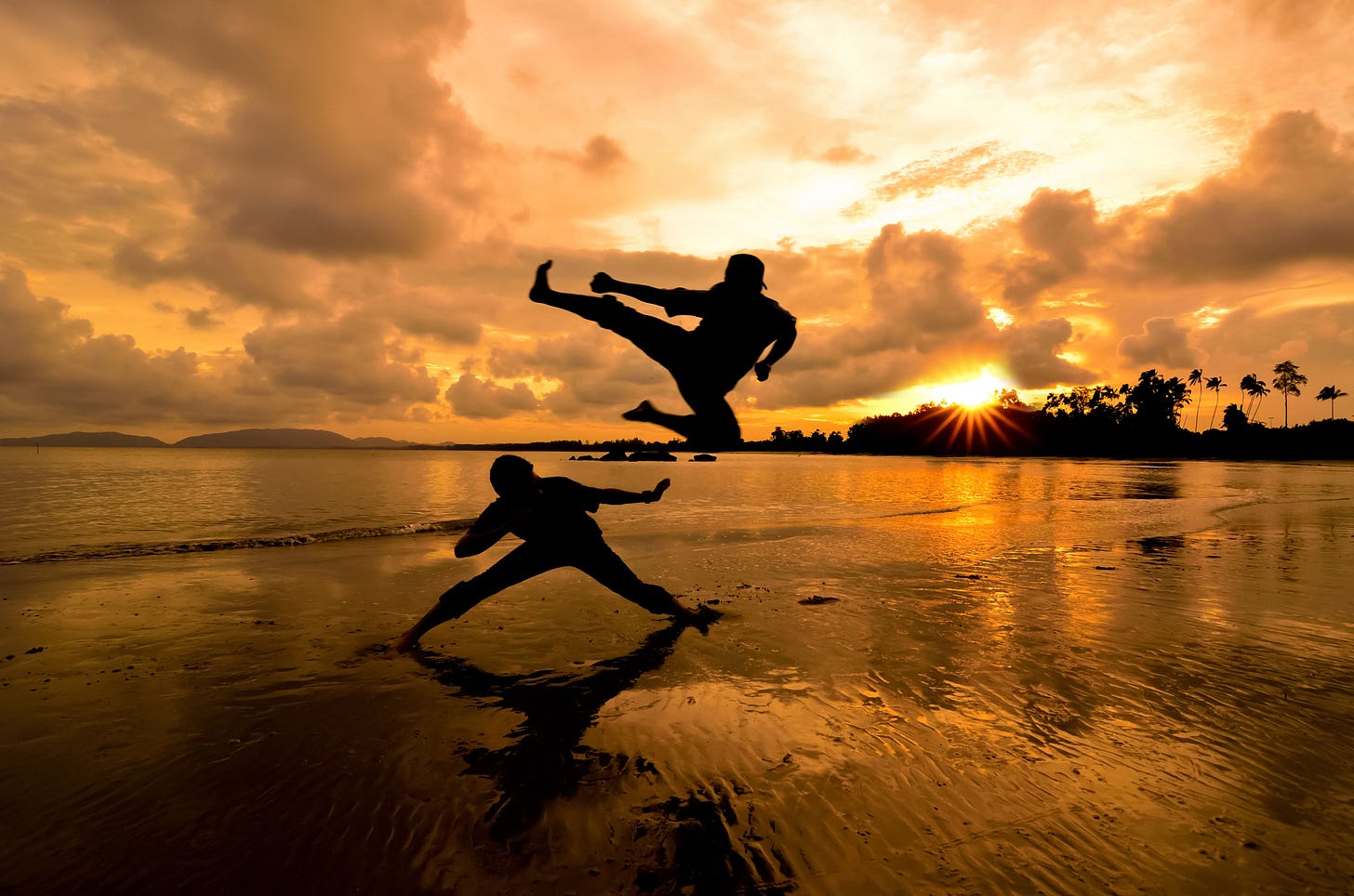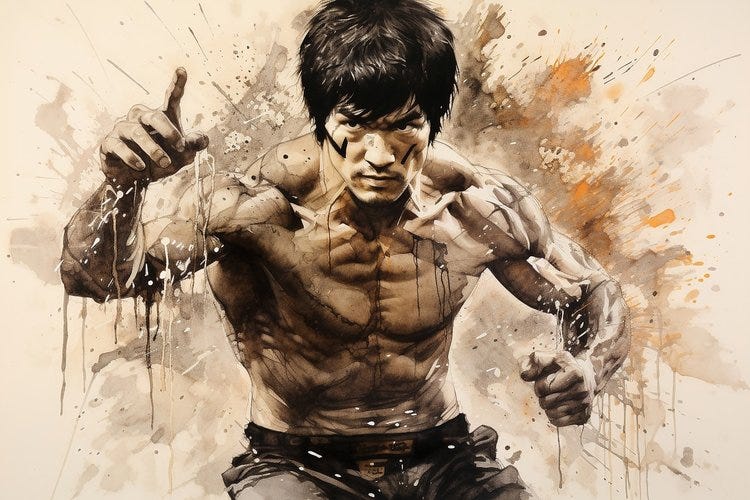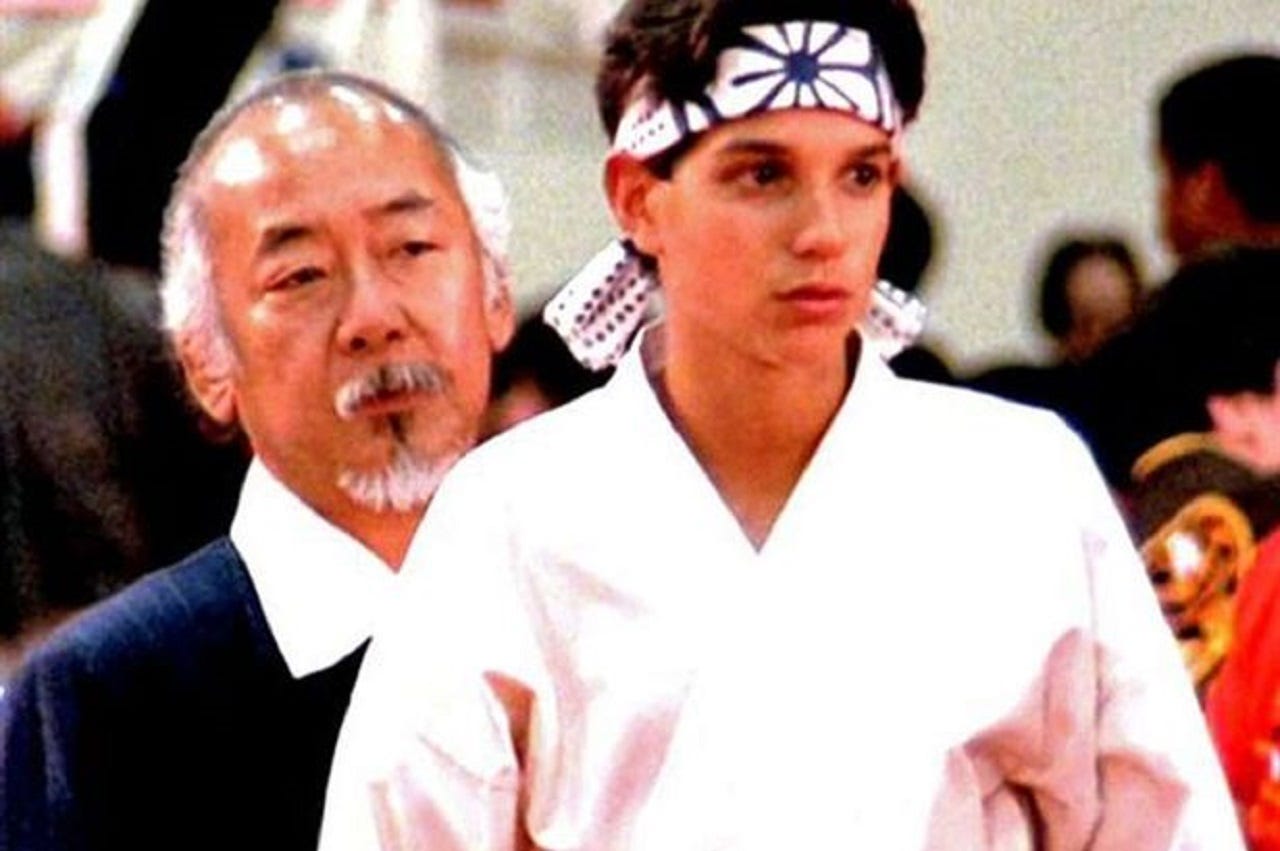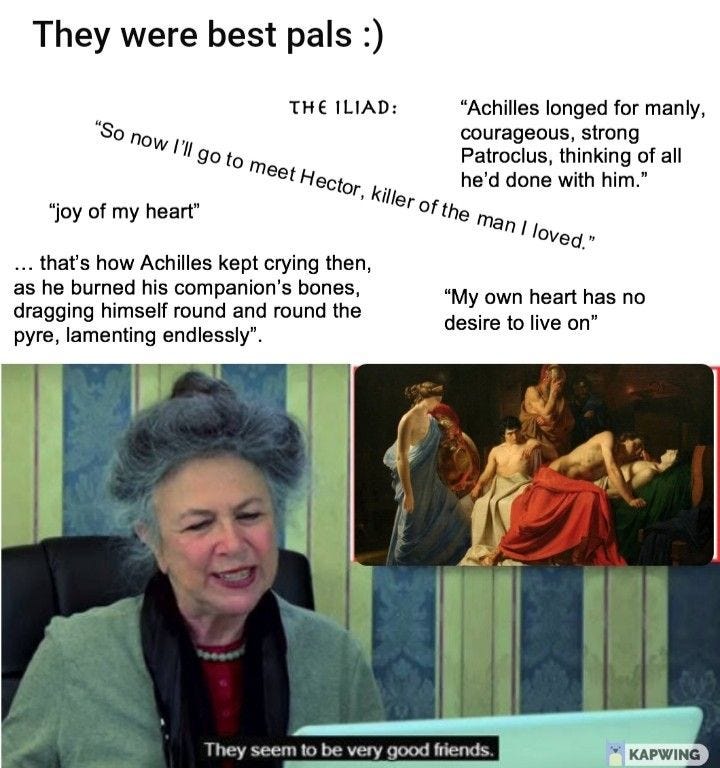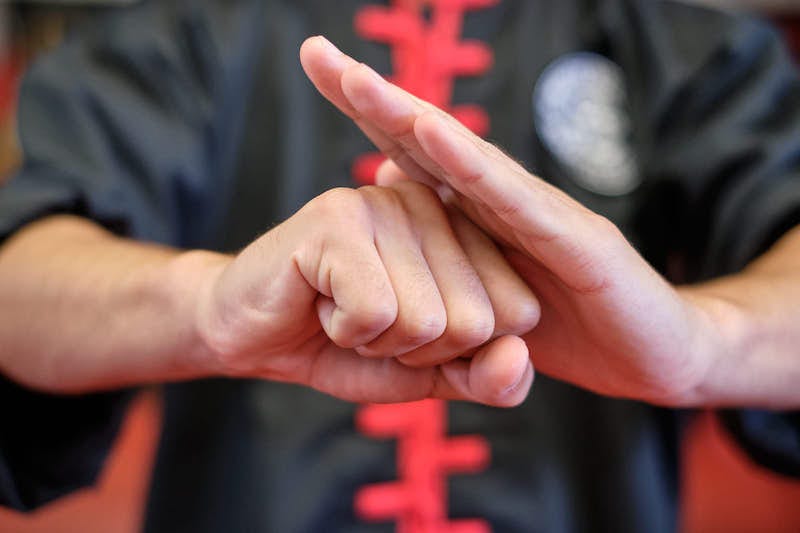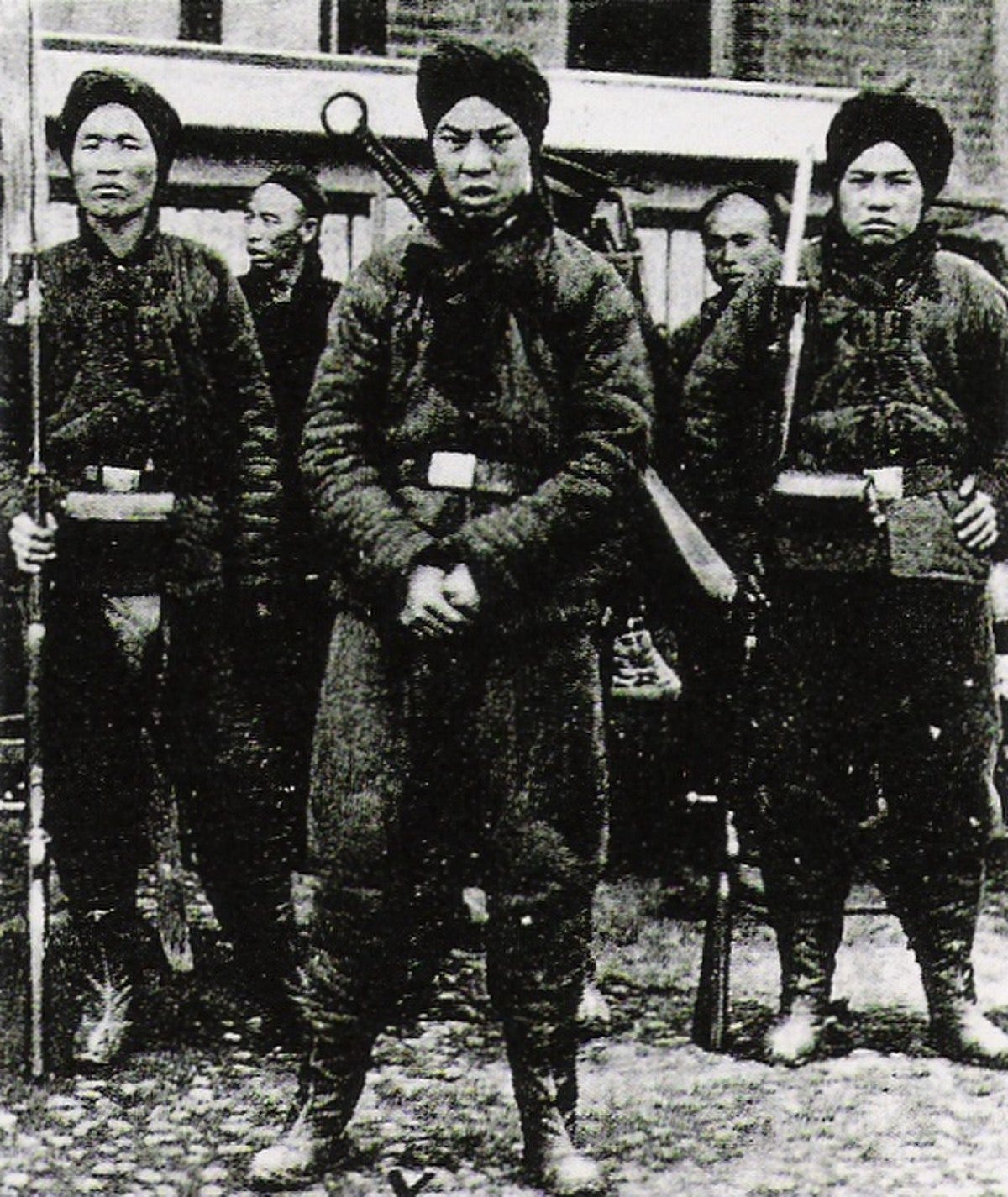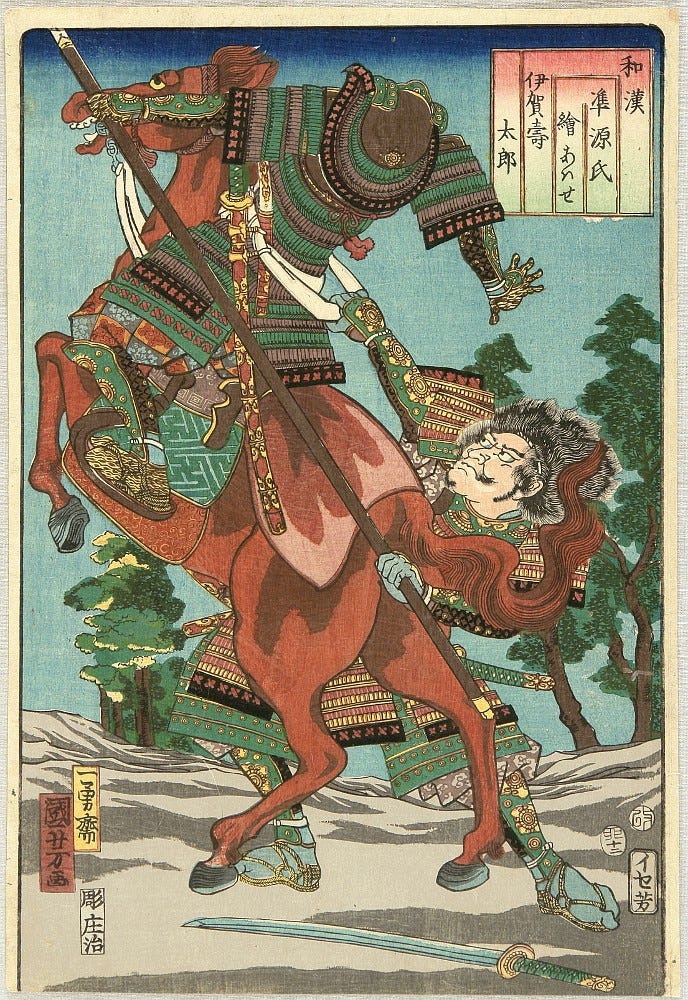Edits by
The Art
What makes something a martial art?
More specifically, looking around the world at the many forms of armed and unarmed combat, where do we draw the line between martial arts and fighting?
Or between martial arts and exercise?
Martial art and meditation?
Again, what makes something a ‘martial art’? What defines it?
Are Eastern origins core to the identity of a martial art? Or is it the combination of religious undertones and the promotion of self-discipline, self-improvement, and enlightenment? Is the development of self-control and humility more important than the instilling of martial skills?
Where are the lines drawn and how deep of a definitional onion layer needs to exist for consideration and earn the title, ‘martial art?’
According to Dan Inosanto, Bruce Lee’s most renown student, in The Collected Wisdom of Martial Arts Icon Dan Inosanto by the Martial Arts Industry Association, he states:
“Jeet Kune Do is about being multidimensional. If a person is not multidimensional, he cannot really function [now]. In the 1950s, style went against style, and everybody punched the same. But nowadays, people strike differently, they attack differently. Some people are grapplers, some are strikers and some are a combination. The structure that fit so well in one decade may not be the structure you would use in the next decade.”
While, Gichin Funakoshi, the founder of Shotokan Karate and known as a ‘father of modern karate,’ says:
“Karate is a technique that permits one to defend himself with his bare hands and fists without weapons.”
Often in popular culture, martial arts are depicted as an almost religiously enlightening experience, using the trope of the wise old hermit teaching the audacious youngster how to control their anger, pride, or other less virtuous qualities through training. Mr. Miyagi’s timeless wisdom of various deep philosophical quotes guiding Daniel-San to not only learning the art of Miyagi-Do, but about life too, in a deep, spiritual journey of kicks and flips.
By Dan Inasanto’s definition of June Kune Do and its nature of being multi-dimensional in its approach to fighting, could Pancrase or the Gladiatorial fighting systems of Ancient Rome be considered a ‘martial art’ in the same vein?
They are multi-dimensional fighting systems that employ striking, grappling, and everything in between.
How about Funakoshi’s view that Karate is an unarmed system of defense without weapons? If that’s the case, couldn’t Boxing, or Freestyle Wrestling accomplish the same? And to be even more niche, what about Glima, Irish Collar and Elbow, and Turkic Belt Wrestling?
Would they not accomplish the same goal as Funakoshi’s Karate? I doubt many even these arts in mind, let alone in a category alongside Karate.
Our popular culture views martial arts as a deeply philosophical and internal journey of self-development - an element of connecting to more intimate levels of culture, religion, and spirituality.
If you were to speak to a practitioner of Mongolian Bohk, I guarantee most would be surprised at the level of spiritual, religious, and cultural connections their wrestling conjures up and the weight it carries within both Inner Mongolia and Mongolia. Would Mongolian Bohk lose the title of ‘martial art,’ simply because it lacks the Buddhist or Daoist religious connections so closely tied with mainstream views? Or because they did not originate in Eastern Asia versus Central?
What about Kali or better yet, Sumo? A practice so heavily connected to Japanese culture and history, harkening back to Medieval Japan and still maintaining many of those long-standing traditions but is almost entirely viewed as a sport over martial practicality.
Additionally, lines are drawn further within the community between ‘traditional’ martial arts and the ‘modern’ mixed martial arts or MMA.
For example, the oldest styles of Karate are about as old as Muay Thai. While common forms of the Japanese striking art, such as Shotokan or Kyokushin, aren't even as old as the Marquess of Queensberry Boxing rules.
But it’s Karate that gets the moniker of a ‘traditional’ martial art, not Boxing or Muay Thai.
Again, it begs the question, what makes a martial art, a martial art?
Generally, what we believe to be obvious, even self-evident when approaching a topic becomes less so when you start diving into the weeds.
, a cognitive-behavioral psychotherapist and author of How to Think Like a Roman Emperor and the Art of Happiness, states:“We often waste our time arguing at cross-purposes when we disagree on the meaning of key terms being taken for granted in an argument. Again, people find this frustrating, because it often requires surprisingly hard work to define familiar concepts."
That hard work is found in establishing a definitional basis of what a word means and is agreed upon by both parties.
This is the basis for one of the most famous philosophical schools of thought, the Socratic method. Socrates, through the dialogues of Plato, built his philosophical discourses and inquiries by focusing on the task of defining words, to get at the truth, with whoever he was conversing with.
In less abstract terms, if we can't pin down the meaning of words adequately enough, how can we hope to build more complex arguments employing them and thus in turn, find truth or even communicate properly?
Defining a 'martial art' is a challenge because it can mean many different things across different periods and to different groups and individuals.
Opinions can be easily skewed with bias and subjectivity, even bureaucratic depending on organizational association or preference. Case and point, some completely ignore facts like the hand-to-hand combat methods codified by Gladiators in Ancient Rome. Instead, display a bias and intellectual preference for more contemporary and esoteric systems because they spawned from East Asia.
The same kind of grouping or reasoning that labels Karate a ‘traditional martial art’ over Muay Thai.
One of the worst of this bias often takes shape by not considering Wrestling a martial art, for whatever reason, whether it be its sport-heavy traditions over ‘martial’ training, lack of cultural rituals, or the belief of a more heavy Western origin, versus Eastern, which is another outright myth.
Wrestling is, in fact, the first martial art found around the world in every society in some form or fashion.
"Many of the attempts to determine the boundaries of the martial arts draw on the model of the Japanese "cognate arts" by distinguishing between Bujutsu (from bu, "warrior," and jutsu, also romanized as jitsu, "technique" or "skill") and budo (from "warrior" and do, "way"). Those forms that are considered Bujutsu are conceived to be combative ancestors of those that are considered part of budo, and the latter are characterized as disciplines derived from the earlier combat forms in order to be used as means of self-enhancement, physically, mentally, and spiritually. Bugei ("martial methods," used to refer collectively to the combat skills), itself, is commonly compartmentalized into various jutsu, yielding, for example, Kenjutsu (technique or art of the sword), just as each way has its own name, in this case, Kendo (way of the sword). Outside the contemporary Western popular context and the influence of the Japanese model, it is clear that a vast number of the world's martial systems do not compartmentalize themselves as armed as distinct from unarmed, as throwing and grappling styles rather than striking arts. Grappling and wrestling "at the sword" in the European tradition; the use of knives, trips, and tackles in the "weaponless kicking art" of Capoeira; the spears and swords (and kicks) of Chinese "Boxing" (Wushu); and the no-holds (or weapons)-barred nature of Burmese Thaing compel a reformulation of the distinctions among martial arts that have informed our popular conceptions of them."
Language is essential to the analysis in this series because ideas don't always translate smoothly across linguistic and cultural barriers. If those hurdles remain unacknowledged, everything forward will fall flat on its face.
So, let's provide some context for how terms will be used moving forward.
‘Martial arts’ will be used as a generalized, umbrella term of codified systems, collected and organized into different practices and traditions of combative (both armed and unarmed), entertainment, and ritual-based applications.
Throughout this series, it will become increasingly evident how easily martial arts can transcend various definitional spheres.
For instance, the Thai Ram Dab, Indonesian Pentjak, and Brazilian Capoeira all feature distinct identities of traditional dance customs and martial art--and could be categorized as both or as only one or the other.
It all depends on the observer presenting them and what their goals entail.
"George Godia characterizes the lack of fit between the contemporary category of sport and the physical culture of traditional societies well. "To kill a lion with a spear needs a different technique and different training than to throw a standardized javelin as far as possible. Spearing a lion was a duty to the young moran [Masai warrior], and different from a throw for leisure, enjoyment or an abstract result in terms of meters, a championship, or a certificate". Perhaps for the same reasons, both our mechanisms for converting combatives (i.e., combat systems to sports) and for categorizing them cross-culturally frequently have fallen short of the mark."
For our purposes, we will be using 'martial arts' in the broadest terms, including sport, combat, military, culture, custom, and so on, using cultural and period-based context when necessary.
However, a more thorough explanation of which bucket of categorization the martial arts falls under will be provided when needed.
The Artist
After defining a ‘martial art,’ or at least laying out the framework for one, the next big question is, what makes a ‘martial artist’? Who are they? What are they?
For most, the first day a student steps onto any martial arts mat or into any academy, they are often met with ideological stances on morality that are likely to be tightly woven into the self-defense curriculum, that they are going to be taught.
Remember, Mr. Miyagi could not solely teach Daniel-San Karate, there was much more to his lessons than fists:
“Lesson not just Karate only. Lesson for whole life! Whole life have a balance, everything be better."
A perfect embodiment of this is the 'Student Creed,’ a staple of martial arts training across continents, disciplines, and even over different generations.
In dojos across the globe, students can be heard delivering some approximation of these three sentences:
"I intend to develop myself in a positive manner and avoid anything that would reduce my mental growth or physical health.
I intend to develop self-discipline, in order to bring out the best in myself and others.
I intend to use what I learn in class constructively and defensively, to help myself and others and never be abusive or offensive."
This mantra provides a fundamental backbone to what may be summed up as ' core' beliefs of what many believe it is to be a 'martial artist.'
The Student Creed, Black Belt Code of Conduct, Black Belt Principles--basically, throw Black Belt in front of a repackaged and watered-down version of Bushido, Buddhism, Daoism, or amalgamation of Eastern and South Asian thought, and you have the ideological ‘doctrines’ encoded in the bulk of martial arts academies. Molding a structured curriculum that uses ethics, in tandem with self-defense, uniquely defines the physical pastime called martial arts.
In some cases, these principles are the centerpiece of a system rather than a closely associated secondary factor.
And with this recipe comes an unquestioned association with moral development, melded with physical and athletic improvement. All of which are then branded, sold, spouted, imitated, preached, rinsed, and repeated in a way that carries a slight flavor of propaganda on the palette.
Sit back and observe some select children’s martial arts classes. All of the creeds and codes yelled in unison might be positive in their intention but, the resemblance to cultish indoctrination seems odd in any other context.
The martial arts market, brand and sell themselves as carrying a distinct ethical and philosophical model of inner self-cultivation and development for their practitioners.
In the immortal words of the great Anderson Silva, this blend isn’t out of place, "is normal."
Training and discipline are often preached to better an athlete's character, build mental toughness, enhance problem-solving skills, teamwork, and other valuable life lessons in the rest of the sports world. However, the magnitude at which they are emphasized in a dojo setting is on an elevated level that is a world of its own.
The value of hitting a training sled, crushing pop flies, or slogging through lay-up drills will never reach the dogmatic heights of drilling martial arts techniques, which so often turn from simple exercise into life-altering parables of insight.
Outside of martial arts, would anyone else evangelize the deep-seated belief that punching stuff is a vehicle towards becoming a ‘higher being’ or ‘enlightened person?’
Yet, the structure of the martial arts holds the distinction of being a physical manifestation of a Buddhist Zen koan, allowing practitioners to become better individuals by studying the fighting arts and achieving a higher self. Along with this presumption often comes thinking that mirrors the nature of an unquestioning religious dogmatism.
In more colloquial terms, as iconic Ultimate Fighting Championship commentator, podcast host, and 10th Planet Jiu-Jitsu black belt Joe Rogan explains it, martial arts are the "ultimate filter for douchebags," and a "vehicle for developing your whole life."
Under Rogan’s outlook, even if you don't quite unlock that third eye of nirvana, at the very least, martial arts will make you suck slightly less as a person.
The self-identity of the martial arts being a catalyst or developer for inner enlightenment and being a ‘better person,’ is not uncommon historically or even abnormal.
More so, to the point, it’s so common, that it is cliche and a trope.
The true martial artist, as advertised throughout time, is the epitome of human goodness. They are both meek and humble, as well as strong and deadly, using their martial skills to protect the weak and vanquish evil. They are a force for good! Often these skills are presented as near superhuman; breaking cement, bending metal bars, and repelling swords to the neck.
The world of martial arts is ripe with everything from magical monks, mulleted Mid-Westerners who could kill a man with a single strike, and wise old hermits waiting around the corner to teach pale, pasty caucasians their ancient discipline.
Stan Lee couldn't write better fiction.
There are two quotes (from authors unknown) that often pop up frequently and further push these ‘main character syndrome’ narratives.
"One must first learn civility before he learns the [martial] art, and one must first know his ethics before he knows his skills," and "a true Taekwondo man is one with the godlike capacity to think and feel for others, irrespective of their rank and position. He possesses ideals so lofty and a mind so delicate, they raise him above all things ignoble and base, yet strengthen his hands to raise those who have fallen, no matter how low. Therefore, the ultimate aim of Taekwondo lies not in victory or defeat, but in the perfection of the character of its participants."
'Nerd learns Kung Fu' to defeat the bully and discovers himself along the way' isn't just an entertainment storyline or a marketing tag for parents looking for a constructive activity for their children.
Adults buy into it too.
The belief that, through the self-mastery of self-defense, one creates a stoic discipline of higher societal values and extends an ‘ancient wisdom’ handed down by wise old masters to new students can be found among any age group.
Now, when you think about the ideal martial artist, in the same way, Basketball players envision Michael Jordan or Golfers Tiger Woods, without question, the epitome of the martial arts, no man is viewed as embodying or emulating the ‘ideal martial artist’ more so than Bruce Lee.
Adored is not a strong enough word, more so revered throughout the world for his philosophy, movies, personality, and most importantly, his martial arts, Bruce Lee is a man whose existence simultaneously shaped the modern martial arts ethos and both American and global culture in only a short 32-year existence on Earth.
However, most don’t realize in his early years, Lee was notorious for street fighting, and not just as a means of self-defense.
Simply put, the man liked mixing it up.
In fact, Lee’s parents feared that because Lee was so often ‘about that life,’ that he needed a change of scenery and according to the ancient scrolls, many believe, is the reason Lee landed in the United States in the first place.
According to martial artist, California State University professor, and History on Fire podcast host
, Hong Kong had a 'vibrant' street fighting culture during Lee's youth, and it was common for brawls to break out between rival academies.Wait, wait…this doesn’t sound like the self-defense and self-improvement of the martial arts espoused by Mr. Miyagi, Oogway, Master Splinter, or any number of mid-sixties white guys who learned the ancient arts of Karate-Do in Okinawa during their TDY’s to the island?
In “Bruce Lee - Part 1,” Episode 77 of History on Fire, Bolelli states:
"If you hold any romanticized ideas about martial arts as a tool for spiritual development or to become a better human being, you can rest assured this did not apply to this phase of Bruce Lee's of life. Or, for that matter, for much of the youth martial art culture of Hong Kong in the 1950s. These guys trained for one reason, and one reason only, and that was to fight and fight they did...a lot."
Lee as a young man maintained a certain reputation among local law enforcement during these ‘very cultured’, ‘totally reputable’, and ‘entirely controlled’ meetings of the minds. And even as he got older, Lee’s altercations outside the spiriting confines of competition never quite ended.
Incidentally, and perhaps somewhat ironically, Lee has also been quoted as being adamantly against martial arts in a sports context.
Bruce was also fairly notorious for his affairs with women in Hollywood throughout his marriage, even on his literal death bed--which belonged to an alleged mistress, Betty Ting Pei.
Of course, some dismiss that bit of scandal, believing Betty and Bruce were just close friends, the dominant narrative thanks to excellent marketing over the years.
Ting Pei has, in fact, admitted to the two’s affair on numerous occasions. She even has a biography that details it, writing:
"Before him, I wasn't serious with relationships, and I knew nothing about love."
Comparatively, Lee allegedly stated that the relationship was "just a fling,” adding that eventually, he planned to dump her, “she doesn't mean anything to me. I have plenty of girls.”
To ‘dump,’ would imply at some point, there was a relationship, and ‘plenty of girls,’ also implies Lee’s extracurriculars. Both of these, are hard to dismiss in the context of the martial art’s ethical principles.
In his book Bruce Lee: A Life, biographer Matthew Polly noted that Robert Baker - a close friend, training partner, and a long-rumored dealer for Lee - was assumed by many for years to have supplied the icon regularly with marijuana.
However, in recently uncovered private letters, weed doesn't seem to be the only substance Lee had a fancy for.
These handwritten letters from Lee’s personal Jeet Kune Do letterhead stationery, alleged to be correspondences between the star and Baker, describe nights out with "little recollection of what had happened."
In a note from 1970, Lee appears to write that:
"I told Linda to call you to forget about the 'stuff' because I really don't need them in my training. I feel that I have 'gained' in trying them, but excessive indulgence of them just isn't in my road in Jeet Kune Do."
“Holy stuff”, was usually mixed in with other codenames like, “Coca-Cola”, “super duper”, “M pills”, “H oil”, and even “good tasting paper”, in an effort by Lee to cover his tracks should he ever be caught.
‘Stuff’ usually refers to weed, but on other occasions, to other habits at the time.
In 1972, Lee asked Baker for "advice on the possibility of shipping some coke to me." He even outlined plans to have the drugs sent to him under a friend's name and address by hiding them in clothing and books to avoid Hong Kong's strict laws.
One letter authenticated by Heritage Auctions from Lee shows an order as follows: "COKE (in large amount)," "ACID (in fair amount)," and "HASH OR GRASS," and inquiring about "psilocybin" or magic mushrooms. There are also repeated orders of "C," "coke," and "Coca-Cola," as well as other less obvious substances, like, "holy stuff," "super duper," "M pills," and "H oil." In the same newly released letters, which provide more insight into Lee's aforementioned marital affairs, biographer Polly noted that it appears "a previously unknown mistress named Teresa" was referenced, an individual Lee apparently tried to meet in secret.
There will be readers whose blood boils at the mere notion of something representing Lee in a negative light.
Unfortunately, all evidence points to the fact that the patron saint of martial arts, a man above critique and deified by all, was, contrary to popular belief, a human being. As blasphemous as it might seem, this man who became the pinnacle of martial arts idealism was far from perfect.
In 1966, ‘Judo’ Gene LeBell was called onto the set for The Green Hornet by the show's stunt coordinator, Bennie Dobbins, specifically to deal with Lee and his treatment of the other stuntmen on set. From accounts at the time, Bruce had been working ‘stiff’ with those on set. Or, as LeBell eloquently puts it, "kicking the shit out of the stuntmen."
Lee wanted the fights to look legit and couldn't be convinced to 'dial it down' a few notches. Dobbins, in response, felt LeBell needed to humble Lee a bit. Simply put, they needed someone to pay Lee back for constantly and intentionally ‘tagging’ his co-workers during the action scenes.
After arriving on set, the story goes that LeBell grabbed Lee, lifted him onto his back into a fireman's carry, and ran around the set, carrying him like a child.
For his part, LeBell described the encounter as follows:
"He started making all those noises that he became famous for, but he didn't try to counter me, so I think he was more surprised than anything else."
At one point, Lee yelled, "Put me down, or I'll kill you!" to which LaBell responded, "I can't put you down, or you'll kill me." LeBell eventually set the June Keet Do legend down, to which he told Lee, "Hey, Bruce, don't kill me. Just kidding, champ."
How about a more modern example and recent embodiment of the true ‘martial artist’, Khabib Nurmagomedov, who is often credited for exemplifying the ‘martial ethos’ of the combat athlete.
Specifically, Nurmagomedov’s handling of rival Conor McGregor during their lead-up to UFC 229, drew regular praise for his composure in press conferences and media appearances.
In the face of the brash, trash-talking showman McGregor, Khabib responded little to the Irishman's insults, taunts, threats, and constant barbs before their scheduled title fight. McGregor, whose ability to entertain and promote regularly puts all but the most iconic professional wrestlers to shame, bombarded his Dagestani opponent nonstop in every possible facet.
But, Khabib regularly remained silent, ready to do his ‘talking’ in the cage--winning by submission in the 4th round of their fight.
Khabib seemed to exhibit the utmost restraint and self-discipline in not engaging with McGregor's antics. Throughout his career, he’s built a reputation as a humble, stoic, and pious Dagestani Muslim.
In many ways, he is what a martial artist should aspire to be.
The flip side of that, however, is that Khabib is also known for having an 'ultra-conservative' worldview, advocating for crackdowns on nightclubs and criticizing rap concerts.
Even going so far as to ask the government to investigate performances for their displays of “filth"-- namely for women performers showing 'a bit of skin.' Nurmagomedov is also known to have close associations and partnerships with the Head of the Chechen Republic, Ramzan Kadyrov.
Kadyrov has become infamous for a laundry list of human rights abuses, including the rounding up, torturing, and execution of gay men.
But, what matters most is he's civil as an athlete and carries himself like a martial artist, right?
Ok, maybe you feel his social conservatism is justified, whether because of religious or cultural beliefs. But Khabib’s incongruities as a disciplined fighter have been on full display inside the cage as well. After defeating McGregor, he continued choking his opponent despite referee intervention and then proceeded to target and go after McGregor's teammates--with Khabib’s entourage trying to jump a defeated McGregor in the cage.
How about the infamous incident where Khabib and his team singled out and intimidated McGregor’s training partner, Artem Lobov, in a hotel? An interaction that was one of the major catalysts that launched the two men’s bitter rivalry.
And what about those Gracies?
That family which brought martial arts into its modern era and according to lore, even designed their Jiu-Jitsu around the philosophy that the small, frail individual could overcome stronger, and large opponents.
From the "Godfather" of Gracie Jiu-Jitsu himself, Helio Gracie:
"Jiu-Jitsu is for the protection of the individual, the older man, the weak, the child, the lady, and the young woman from being dominated and hurt by some bum because they don't have the physical attributes to defend themselves."
Of course, this same Helio Gracie, who saw Jiu-Jitsu as a form of defense for the weak, was arrested for assaulting Rufino Dos Santos, after Dos Santos defeated Helio’s brother, Carlos Gracie.
And get this, it wasn't just a 'mano a mano' assault. It was a WWE-style affair, featuring the whole stable of the ‘Gracie Brothers’, weapons in hand. The surprise assault resulted in surgery and career-ending injuries for Dos Santos. And this event is far from isolated in the history of the Gracie clan and as we will find in later on, morals, ethics, and spirituality are often an afterthought.
Now, all of this isn’t to degrade Lee.
However, so much as it is to point out that the idea of Bruce Lee as an inhuman, infallible, personification of perfection who could defeat any man on Earth, or a moral deity on par with Jesus of Nazareth, should seem cultish. Regardless of Lee's undeniable global impact, not only in the martial arts, philosophy, and as a pop culture phenomenon, his fame shouldn’t deter critical study.
The same is true for Nurmagomedov, the Gracies, or any of the pillars and icons of the martial arts and combat sports.
Unfortunately, objective or critical study is not the case. Lee is still deified. Many ignore Nurmagomedov’s other political connections or actions, and Gracie’s real legacy isn’t even known around Jiu-Jitsu circles and their legend is often as mythological as a Greek epic.
To criticize Lee, question his legacy, or have even a critical take about him, is to incur an onslaught of zealot-like responses from both martial artists and non-practitioners alike; a blowback comparable to disputing religious doctrine, an equivalent to sacrilege.
While not as extreme as Lee, Nurmagomedov, the Gracies, and many other related individuals will result in a similar kind of negative pushback and reaction.
To coin a phrase:
"If you meet the Buddha on the road, kill him."
No one and nothing should be above reproach.
Whether it's the deification of Lee, the belief in martial arts’ ability to transform men and women into distinctly ethical figures, or the mythology that the martial arts are rooted in strong morals, these ideas are all incongruous with the fact that martial artists are still human.
For every George St. Pierre on one side of the scale, there will also be a "B.J." Penn, Anthony "Rumble" Johnson, Matt Hughes, Aleksander Emelianenko, Jon "Bones" Jones, Travis Fulton, Conor McGregor, Lloyd Irving, Ricardo De La Riva, Jonathan Paul Koppenhaver, or Joseph Hyungmin "Joe" Son.
Even Vladimir Putin and Osama Bin Laden were both martial artists and I highly doubt any rational person is looking for moral guidance from them.
The notion of the ‘ethical martial artist’ is an oversimplification of actuality and a revision and repackaging of reality. It’s an idolization and romanticization; a ‘whitewashing,’ that paints a wholly incomplete picture of the martial arts and martial artists that is ineffective and blatantly inaccurate.
It doesn't acknowledge the reality of humanity and the complexity of an individual or even the practice, limiting both within an ideological box and a caricature.
To both the layperson and even the most learned martial artist, the unquestioning notion that, like a religious baptism, these skills lead to one becoming a more ethical, morally virtuous person is extremely naive.
It is no different than believing that wars have never been fought in the name of Buddhism or that Christianity, Islam, or Judaism, have a monopoly on morals, ethics, and virtue over atheists and agnostics.
These kinds of idealization would be in the same vein as seeing military soldiers as distinctly honorable or morally incorrupt because that's what their narrative tells us.
Just because someone was a Navy SEAL doesn't make them any more or less prone to honor than a Catholic priest may be to ethics or morality.
Yes, by their function, they should be—but 'should' doesn't account for reality.
There cannot be Yang without Yin, just as there conceptually cannot be black without white, dark without light, low without high, or good without evil.
Martial artists are no different. Those who dedicate themselves to the fighting arts fall short of the moral compass just as often as they have been a guiding light.
Unfortunately, most either don't see it, don't want to hear about it, or entirely disassociate from the ‘bad apples’ from being part of the martial arts community. When in fact, whether one likes it or not, they are. Without any firm structure as to what makes a martial art or accounts for real martial arts training, the idea of the martial arts 'community' is almost too nebulous to be escaped.
To even act surprised that someone trained in combat arts would stoop to violent actions that they’ve trained themselves in for years, isn’t expressing an honest understanding of martial arts.
Naive might not be a strong enough word if you read that with any level of self-reflective thought.
A gun is a tool that can be used defensively or aggressively; it has positive and negative purposes. However, the basic function of a gun never changes. A person can be as pro-2nd Amendment or as pro-gun control as they want, but neither philosophical stance changes the function of what a gun does.
Its function is to kill.
And if you’re questioning my train of thought, how about a quote from one of the most accomplished grappling coaches of the 21st century, and arguably, one of the most influential of all time, John Danaher:
“A knife can be used to make a sandwich; a knife can be used to save somebody’s life—as you’re struggling to get out of a car, you can cut the seatbelt and escape—a knife can be used to serve justice, it can be used for murder. It can be used for the greatest things, the most mundane things, and the most terrible things. It’s morally neutral. It’s only as good as its owner. Jiu Jitsu is exactly the same. Jiu Jitsu doesn’t make you good, it doesn’t make you bad. It will just reinforce what you already are. If you’re an asshole, it will make you a worse asshole. If you’re a good person, it will make you a better person.”
Martial arts are very much the same, developed for fighting, for war, and physical violence. And violence, by its nature, isn't something that is going to attract peaceful people.
Outside of military service or coaching, there isn't exactly a massive list of socially acceptable occupations where resume accolades include, ‘can break another man's arm’ that lead to employment opportunities of a 9-5.
This is a trade that forges its skills in violent struggles, and yet, it's expected for the masters of these crafts to be saints. Taking the old saying that "it is better to be a warrior in a garden than a gardener in a war" to unrealistic levels.
Fighting begets those who fight like war creates warriors. These aren’t businesses of morals or ethics. It's kill or be killed.
The act of physically overcoming that which stands in front of you.
Violent people are going to do violent things.
How often have we heard professional fighters say something to the tune of, ‘If I wasn't fighting, I'd be on the streets doing something worse. Fighting saved me.’
But it’s not just fighting that saved them—it's that they found a legal way to fight. This might come across as cynical, but it’s similar in concept to a serial killer joining the Marines.
It's not in the performance of some noble service, it's turning homicide into legal killing.
Do honorable people enter the military or become professional combat athletes? Without question. But, individuals with polar opposite motivations do as well and are just as likely to thrive.
Respect, at least from a perspective of skills, accomplishments, and athleticism, is without question to be given to many of the famous martial artists and combat athletes, despite their inability to constantly live up to the ideals extolled by the ‘proto-typical’ martial arts ethics and doctrines.
Instead of making exceptions for these celebrities and needing to re-examine or redefine what a ‘martial artist’ is, we should acknowledge the duality of human nature and accept, that a martial artist, like any other person, is complex and can be both ‘good’ and ‘bad,’ without reinventing the wheel
We can view Ceasar or Ghengis Khan as amazing generals on the battlefield, but absolutely butchers and mass murderers at the same time. We can also admire Theodore Roosevelt for his almost inhuman levels of energy and inability to walk away from any challenge, even his abilities as a statesman, conservation, and standing up to the ‘bullies’ of his era, while not forgetting he both desired a true American Empire and held abhorrent racial beliefs.
Being a great or exceptional martial artist does not have to be synonymous with being a great person.
Self-Identity
However, acknowledging this aspect is easier said than done, because we now face the elephant in the room that sits in stark contrast to reality.
The self-identity of the martial arts. It’s soul and marketing scheme that is so heavily intertwined with those moral components.
People don’t want to like violent or bad people, and they certainly don’t want to praise or champion outright fighting and violence for the sake of violence.
As noted prior, sometimes detours are going to arise on this journey and we just hit our first, so you’ll have to indulge me on this slight scenic route.
We’ve already established a rabbit hole of semantics and 'interpretation' debates that arise in establishing the parameters of a ‘martial art,’ and in turn, a ‘martial artist,’ depending on who's holding the discussion.
Understanding that fact is particularly useful, given that the mainstream understanding belief is martial arts were been born in China (or, in a larger part, East Asia) and developed outward from there.
This is, of course, utterly false.
Sadly, common misconceptions drive the conversation and lead to frequent doubling down on martial arts' religious and ethical dogmas, along with historical falsehoods, misinformation, and outright myth, further narrowing discussions into more limited scopes rather than opening new talking points.
Even if it was the case that the bulk of martial arts practiced worldwide maintained a direct lineage from East Asia and the region’s many distinct faiths, modern martial arts are very clearly far removed from those Buddhist, Daoist, or Bushido origins.
If there is any connection to them at all.
Regardless, these philosophical doctrines have securely fastened themselves to the ‘martial art wagon’, and become synonymous with the practice even if not apparent.
So what continues these traditional stereotypes, despite their limited connection to the past and a seeming lack of influence in the present?
There’s an argument that pervading remnants of Western colonialism and racial stereotypes towards the ‘mystic East’ still exist on deeper, less overt, levels, keeping outdated ideas afloat. However, if that's the case, why do similar sentiments from Asia exist, almost copied and pasted from those in the West?
Chatri Sityodtong, the chairman and CEO of ONE Championship - a Singapore-based mixed martial arts (MMA) and multi-combat sports promotion whose entire paradigm is being the ‘anti-UFC’ - has often stated that the goal of his fighting promotion is to maintain a ‘wholesome’ image of the martial arts.
"I always say our success is measured when a child puts a poster of one of our heroes on his or her bedroom wall,” says Sidyotong, and one of ONE Championship’s aims is:
“I want parents to know that their children are safe in the hands of our heroes. We celebrate values of integrity, humility, honor, respect, courage, discipline, and compassion. ONE Championship promotes good values. People know we represent a celebration of Asia's greatest treasure, which is martial arts; we attract those martial artists who exemplify our values and who share our DNA."
So, leaning towards considering Eastern stereotypes would, at the very least, not quite capture the complete picture and would probably be an outlier of the overall zeitgeist.
In an interview for the documentary Needle Through Brick, Patrick Daly spoke with several Kung Fu masters for the film which never made the cut but did make it into his essay, Fighting Modernity: Traditional Chinese Martial Arts and the Transmission of Intangible Cultural Heritage.
In Daly’s paper, he highlights one interview that perfectly encapsulates the tightly woven connection between morality and martial arts from the Chinese cultural perspective.
“During an extensive interview with several kung fu masters in Sibu, we sat at a food court, drinking beer, while one master began telling stories about his youth. After a number of entertaining anecdotes he got more somber and mentioned that it is sad that people were not learning traditional kung fu. When I asked why he was not more active teaching himself, he answered in a gravelly voice: In my opinion, the world has changed. I never teach my son and my grandson. People asked me to teach, but people’s minds nowadays are wicked. You know them in appearance but not their inner character. If I accept him as my disciple, I must know his character! If he has a quick temper, after learning, he may create problem and will bring disgrace to the school and even your name. People will look for his master. They will come to find me. A real master can only teach real kung fu to his disciple who learns under him for at least 10 years in order to know his character well or he will create problems. We’ll not teach the practical use of kung fu to those who learn for only 2 to 3 years. This is the traditional culture. That’s why a lot becomes extinct. Chinese traditional kung fu is like this.”
This concept of ten years will be returned to, so for now, let it simmer in the subconscious.
Regardless, while this is just one answer, from one master, interviews throughout the documentary share similar, if not identical ideas and threads.
All of this lends Sityodtong’ statements on “DNA” even more credibility as evidence of a mainstream, deeply-rooted, and core attitude that crosses geographic and cultural boundaries towards what martial arts embody.
A self-image of morality, ethics, and self-development is not just eaten up by Westerners.
Even more than that, it's not even a modern concept. History is filled with examples of the same 'martial arts marketing'; men and women who acquire supernatural abilities, strength, and self-enlightenment, all mirroring a Shaw Brothers’ storyline.
Staying on the Chinese Kung Fu train, these arts, in particular, have a nasty habit of being littered throughout their history with half-truths, exaggerations, and some of the clearest examples of the monastic Ubermensch ideas that are gained through the martial arts training.
One example, in particular, that has had lasting effects on Chinese martial arts, and their image, can be found in the Boxers Rebellion in China.
Many Kung Fu instructors lost public credibility because the idea of them possessing otherworldly powers or being supernatural masters of combat was easily debunked when guns came into the mix.
These ‘masters’ claimed they could withstand bullets thanks to practices like Qigong, which unfortunately went exactly as expected.
“The Boxer's lost, with terrible consequences. The Boxer's Rebellion shocked China into the modern world with machine-gun fire and Beijing was effectively conquered by the Western nations [Russia, Britain, the United States, France, Austria-Hungary, and Italy] and the newly industrialized Japan. The foreigners burned the impact of their victory into the Chinese consciousness by carving China up into "concessions," or colonies. Before this defeat, the Chinese often believed that martial arts could border on the “supernatural." But if many were not convinced that guns were far superior to traditional fighting forms, the Boxer’s Rebellion changed their minds.”
Today, China's belief that martial arts holds a distinguished cultural and spiritual link maintains some heavy connections with state propaganda.
The government sees a great deal of value in promoting a positive image of the traditional martial arts and Chinese ‘soft-power’, or influence through culture rather than force. In 2017, Xu Xiaodong, a Beijing-based MMA fighter, challenged a Tai Chi master to a fight to expose what he felt were ‘fake’ martial arts.
This fight, like the Boxer’s Kung Fu against military firearms, also went how you'd expect it to.
In what should be an embarrassment to any martial artist, Xu defeated this ‘master’ in less than ten seconds with a half-hearted teep kick that set up the fight-ending lead hand jab, causing Xu’s opponent to verbally quit the match.
The kind of stiff jab that no serious martial artist, let alone master, should ever verbally quit from.
After Xiadong's lopsided victory, the reaction from the Chinese public was surprisingly similar to reactions after the first Ultimate Fighting Championship.
Rather than embrace the ‘scientific method' brought to life through combat, there was a backlash; threats to Xiaodong were charged with a feeling that fights like these were humiliating to traditional Chinese culture.
The Chinese Wushu Association stated they "suspected illegal actions that violate the morals of martial arts."
Even high-level members of the Chinese Communist Party were shown to be less than ‘fans’ of what they viewed as ‘Western’ martial arts marring the image of Chinese tradition, which according to Deadspin:
“The Chinese government would really like for him [Xu] to stop his war against tai chi. As of this writing, Xu has been ordered to publicly apologize [to the master’s he’s beaten]; had to pay the equivalent of USD $36,000 in fines and legal fees; had his social credit score lowered after he refused to apologize, preventing him temporarily from traveling by plane or high-speed train; had one of his gyms shut down; and seen a total of 11 social media accounts mysteriously disappear.”
In an article concerning the incident in TIME Magazine, Shaolin temple abbot Shi Yong Xin stated Kung Fu:
“Can't be compared to MMA because its true essence is spiritual rather than simply physical, bringing not superpowers but inner peace."
Gene Ching, the former associate publisher of Kung Fu Tai Chi Magazine and KungFuMagazine.com, as well as a weapons master featured on El Rey Networks’ Man At Arms, says:
“China has a romantic notion of martial arts, and the kind of braggadocio seen in MMA (ie. Khabib vs. McGregor) doesn’t fit within their cultural view, so it’s not encouraged. When you have MMA fighters challenging Tai Chi practitioners, that’s painfully tone deaf in terms of what each style looks to achieve…Another reason is that Kung Fu is working for a longer game, so it’s more sophisticated, and in this case, to a fault. A practitioner doesn’t really come into mastery until their thirties, and that’s outside the window of MMA competitors.”
These sentiments are similarly echoed in Japan, wherein another ‘father of modern Karate’ Anko Itosu, provides another example in his Ten Precepts of Karate-do:
"Tode [Karate] is primarily for the benefit of health. To protect one's parents or one's master, it is proper to attack a foe regardless of one's own life. Never attack a lone adversary. If one meets a villain or a ruffian, one should not use tode but simply parry and step aside."
Or even, Morihei Ueshiba, the founder of Aikido:
“The Way of the Warrior has been misunderstood. It is not a means to kill and destroy others. Those who seek to compete and better one another are making a terrible mistake. To smash, injure, or destroy is the worst thing a human being can do. The real Way of a Warrior is to prevent such slaughter — it is the Art of Peace, the power of love.”
And so this theme, this mantra towards the martial arts and its emphasis on creating higher moral and social values remains on loop.
For Eastern martial arts, such as Muay Thai, Kung Fu, Karate, Taekwondo, or Lethwei, there is a tightly bound connection to cultural traditions in a way Freestyle Wrestling or Boxing cannot compare.
Kung Fu in particular, has existed side-by-side with Chinese civilization for practically the entirety of the nation’s 4,000-year history, along with a deeply spiritual and religious component fastened along with this extensive history.
As influential and unique to the United States as Baseball or American Football are, they are still, at heart, just games.
Even in the more extreme examples of ‘hooliganism’ found in English Football or ‘ultras’ in Italian Calcio, the religious and cultural identities do not intertwine in the national mind.
They, as Sityodtong put it, lack the element of "DNA."
Again, martial arts create a self-identity that has resulted in maintaining dual national and cultural elements, a cross-pollination of religious and social values shaping this “DNA,” as well as secular values too. American Football and Baseball are recognized as American pastimes, nothing more. Just as soccer (or futbol/football) is recognized as European in origin, but is globally the Earth’s most-watched athletic pursuit.
And while these sports have maintained cultural aspects unique to their place of birth, they do not pull with them the religious connotations the martial arts can’t seem to shake.
Consider a modern martial art like Brazilian Jiu-Jitsu, separated almost entirely from Eastern thought and closely connected with Judeo-Christian faiths and the West because of Brazil's own history and connections with Europe.
Yet, the idea of morality specific to Eastern religions has weaved itself into this Brazilian self-defense system and doesn't skip a beat.
From Carlos Gracie, "The biggest lesson I learned from jiu-jitsu was how to truly know myself" to Fábio Gurgel, "The best thing about jiu-jitsu is the honor it provides." Or, arguably one of the greatest martial artists to ever live, Rickson Gracie, "Fighting is not a physical thing, it is a spiritual thing."
And as we dive deeper, the contradictions within the self-identity become more self-evident.
For example, within combat sports, where a fighter’s goal is to maul their opponent within caged walls for money and entertainment, the values of ‘morality’ developed through martial arts are often repeated.
A fighter should be humble in victory and defeat, respectful of their opponent, and appreciative of the opportunity to test their skills against another artist of similar reputation. How often are proclamations of thanks to a victor's ‘Lord and Savior,’ for the blessings to overcome an opponent left on the canvas in a bloody mess made? No, these aren’t the sentiments of an ancient Pagan or old Norse. They are ironically echoed religious praise directed to a deity of pacifism.
Gratitude for beating an opponent senseless to a God of love is viewed as less blasphemous than ecstatically proclaiming after winning, "Hell, I might even get on top of my wife tonight!"
The answer?
These are the words of a ‘cage fighter,’ not the noble martial artist. The difference between "I intend to use what I learn in class constructively and defensively, to help myself and others and never be abusive or offensive" side by side with the words of old-school UFC legend Tank Abbot, who once announced that, "Beating people up is a positive thing."
If those opposing stances are confusing, the spirit of martial arts says that it's only OK to elbow your opponent's head until they bleed, when a victor is humble at the fight's end. It doesn't matter that they just punted their kneeling competitor's skull, leaving them lifeless and limp, so long as that punt is followed by a respectful bow. The second a fighter shows the slightest inclination of being arrogant, cocky, or (heaven forbid) superior?
Welp, buckaroo, that's where a line is drawn!
Everything about the cage fighter, the prizefighter, the shooter, those who fight for fun, glory, and all the ‘wrong reasons’ spits in the face of the martial class of artists who exude meekness, respect, and higher values of self and humanity—human cockfighting versus skilled artists and athletes.
It can fit within the self-identity mold martial artists have created for themselves, but honestly, why are the two mutually exclusive?
To believe that they are not one and the same, or they can’t intermingle, intersect or simply exist in the same duality would be a complete misrepresentation of history.
Martial artists are not some distinct monastic class exempt from human nature. Most, in fact, have never been and will never be.
Shaolin monks, whose religious practice bore an explicit doctrine of nonviolence, were often hired as mercenaries to the ruling dynasties of China; fighting wars and settling conflicts for the State.
The Samurai, while famed for their ‘Bushido’ code and their knight-like ‘code of honor,’ also encouraged some of the cruelest actions in human history.
To not acknowledge these kinds of points is pure revisionism.
Samurai were not elite, ‘noble’ warriors who would rather die than face dishonor. They murdered peasants. They were pirates. They were brutes who tested weapons on tied and subdued human subjects. In the worst cases, young men or boys were required to become wakashu - a combination of trainee and field wife - for older warriors until completing their apprenticeship; forced to sexually ‘yield’ to their older Samurai ‘mentors,’ less they risk shame and abuse.
Remember, Bruce Lee, famous martial artist and modern philosopher?
Also, a quick-tempered, philanderer, who loved street pharmaceuticals, without needing to get too repetitive and backtrack. I think the point has been made.
Martial artists, and more so martial arts, can exist in a sphere of both violence and peace, discipline and debauchery, bordering on religious piety and sports entertainment extravagance, without feeling icky or like a hypocrite.
Luckily, this series hopes to help with that and change some minds.
Citations:
The collected wisdom of martial arts icon Dan Inosanto. Martial Arts Industry Association. (n.d.). Retrieved July 12, 2022, from https://www.maiahub.com/blog/the-collected-wisdom-of-martial-arts-icon-dan-inosanto
Funakoshi, G. (1973). Karate-dō Kyōhan the master text. Kodansha Internat.
Green, T. A. (2001). Martial arts of the world: an encyclopedia. ABC-CLIO
Pat Morita as Miyagi, The Karate Kid (1984), IMDb
Lover still so glad Bruce Lee came into her life. South China Morning Post. (2008, July 19). https://www.scmp.com/article/645947/lover-still-so-glad-bruce-lee-came-her-life.
Polly, M. (2018). Bruce Lee: A life.
Tabuena, A. (2021, July 6). 'Holy stuff' - Bruce LEE'S letters Document shipments and orders of cocaine, Acid, other drugs. Bloody Elbow. https://www.bloodyelbow.com/2021/7/6/22564733/holy-stuff-bruce-lee-letters-document-shipments-and-orders-of-cocaine-acid-hash-marijuana.
Debunking Quentin TARANTINO'S 'MOCKERY' of Bruce Lee. OZY. (2020, January 29). https://www.ozy.com/true-and-stories/debunking-quentin-tarantinos-mockery-of-bruce-lee/95956/.
Zidan, K. (2018, August 17). Khabib Nurmagomedov outraged by 'MODERN Dagestan' for hosting Hip-hop concert, receives backlash. Bloody Elbow. https://www.bloodyelbow.com/2018/8/17/17704528/khabib-nurmagomedov-outraged-by-modern-dagestan-for-hosting-hip-hop-concert-receives-backlash.
Zidan, K. (2019, February 26). Producer threatened after UFC champ Khabib nurmagomedov criticizes staging of play in dagestan. Bloody Elbow. https://www.bloodyelbow.com/2019/2/26/18241464/producer-threatened-ufc-champ-khabib-nurmagomedov-criticizes-play-dagestan-censorship-crime-putin.
Zidan, K. (2018, September 21). All the CHAMPION'S Men: A look at the shady figures linked to UFC champ Khabib Nurmagomedov. Bloody Elbow. https://www.bloodyelbow.com/2018/9/21/17886960/ufc-feature-khabib-nurmagomedov-conor-mcgregor-shady-kadyrov-magomedov-abdelaziz-karim-zidan-mma.
YouTube. (2018). YouTube.
Frank, S. (2017, July 10). The jujitsu master turning an ancient art into a modern science. The New Yorker. Retrieved July 18, 2022, from https://www.newyorker.com/culture/persons-of-interest/the-jujitsu-master-turning-an-ancient-art-into-a-modern-science
Dawson, A. (2019, October 9). Asia's $1 BILLION Fight firm is exporting ITS 'wholesome' image to the us to take On UFC, a company it says Taints MMA by promoting 'anger, hatred, and violence'. Business Insider. https://www.businessinsider.com/one-ceo-chatri-sityodtong-says-ufc-butchers-mma-2019-10.
Daly, P. 2012. Fighting modernity: traditional chinese martial arts and the transmission of
intangible cultural heritage. In. Daly, P. & Winter, T. (eds). Routledge Handbook of Heritage in
Asia. London: Routledge
Frantzis, B., 1998. The power of internal martial arts. Berkeley, Calif.: North Atlantic Books.
Chinese mixed martial arts fighter xu xiaodong just wants TO 'SURVIVE'. South China Morning Post. (2020, February 15). https://www.scmp.com/news/china/society/article/3048431/chinese-mixed-martial-arts-fighter-xu-xiaodong-rose-fame.
He never intended to become a political dissident, but then he started beating up Tai Chi Masters. Deadspin. (2019, October 3). Retrieved February 2, 2022, from https://deadspin.com/he-never-intended-to-become-a-political-dissident-but-1838706430
Campbell, C. (2018, November 8). This Chinese mma fighter is taking on Kung FU GRANDMASTERS. Time. https://time.com/5448811/mma-kung-fu-xu-xiaodong/.
Massari, C. (2019, March 12). Shuai Jiao: Finding China's martial arts renaissance in a 4,000-year-old wrestling system. Bloody Elbow. Retrieved July 14, 2022, from https://www.bloodyelbow.com/2019/3/12/18242708/shuai-jiao-finding-chinas-martial-arts-renaissance-in-a-4000-year-old-wrestling-system
Anko Itosu: The Ten precepts OF KARATE-DO. SuiBuKan. (n.d.). https://suibukan.com/content/301/anko-itosu-ten-precepts-karate-do.
Reynolds, Garr. (2012). Presentation zen : simple ideas on presentation design and delivery. Berkeley, CA :New Riders,
B. J. J. W., By, -, & BJJ World. (2021, April 30). 50 famous Jiu-Jitsu and bjj quotes. BJJ World. https://bjj-world.com/famous-jiu-jitsu-quotes/.
Sherdog.com. (2012, July 26). Sherdog's top 10: POST-FIGHT interviews and moments - CENTENNIAL MAN. Sherdog. https://www.sherdog.com/news/articles/10/Sherdogs-Top-10-PostFight-Interviews-and-Moments-44473.
Talked to tank abbot tonight. (n.d.). http://www.getbig.com/boards/index.php?topic=395040.0.
Poisuo, P. (2019, July 18). Messed up things you didn't know about the samurai. Grunge.com. https://www.grunge.com/158911/messed-up-things-you-didnt-know-about-the-samurai/.

